2017 Ski-Doo MXZ X 850 Review + Video
Ski-Doo steps up with an excellent fourth generation REV
During the course of one night in Riviere-du-Loup, Quebec, Ski-Doo gave us the inside scoop on its 2017 product line, glossing over the not-so-new models in favor of directing the bulk of the presentation toward its all-new fourth generation Rotax 850cc two-stroke twin and the Gen-4 platform it would power. The following day we did a test ride of this new platform and engine combination at Ski-Doo’s Quebec R&D center where we formed our early opinions under the constant guidance of Ski-Doo engineering and marketing staff. About a month later we moved to West Yellowstone for the annual snowmobile product evaluations where we established our own riding protocols and gained new insights into the Gen-4 based on prior riding experience and the ability to work the sleds against competitive products.
Our riding experiences both in Quebec and West Yellowstone left us with a very positive impression of the new Ski-Doo GEN-4 MXZ X 850. Ski-Doo has done an excellent job of evolving its already top drawer REV series into a newer and even better package that will suit a wide variety of serious riders. Variants of the new GEN-4 chassis appear in a new Renegade, a new Summit and the MXZ models. For serious trail riders there are just two “850s” for 2017, the “base” MXZ TNT 850 and this MXZ X 850, which was available only as a preseason “special.” The early purchase version offered a few features to differentiate it from the MXZ TNT variant that is available for sale all year round. Nice to have, yes, but they are not deal-killers against the TNT version.
Get the Flash Player to see this player.
Ski-Doo claimed that this new platform and its new engine package took about three years to process from blank screen to on-snow pre-production model. According to Jose Boisjoli, BRP/Ski-Doo chief executive, the new sled is designed to elevate the riding experience in virtually all things snowmobile. It is expected to be Ski-Doo’s most powerful and top performing two-stroke as well as the most innovative and best handling the company has ever produced.
While the sled carries the “REV” moniker, it is all new. Not to say that ideas, concepts and things that work weren’t borrowed or, at the very least, used to inspire this new fourth generation platform and evolved direct-injection ETEC twin.
Ski-Doo and its Rotax group has the experience and capability to create just about any engine design it wants. For the new sled Ski-Doo engineers could have asked for just about any engine configuration from Inline, V-Twin, boxer or any combustion mode, two-stroke or four-stroke. It was hinted at one meeting that using a turbocharged version of the Rotax 1200 4-TEC had been a consideration, but all that adds weight, additional plumbing for cooling and eats up precious underhood real estate. No, the use of a new ETEC twin with next generation electronics and larger displacement worked best.
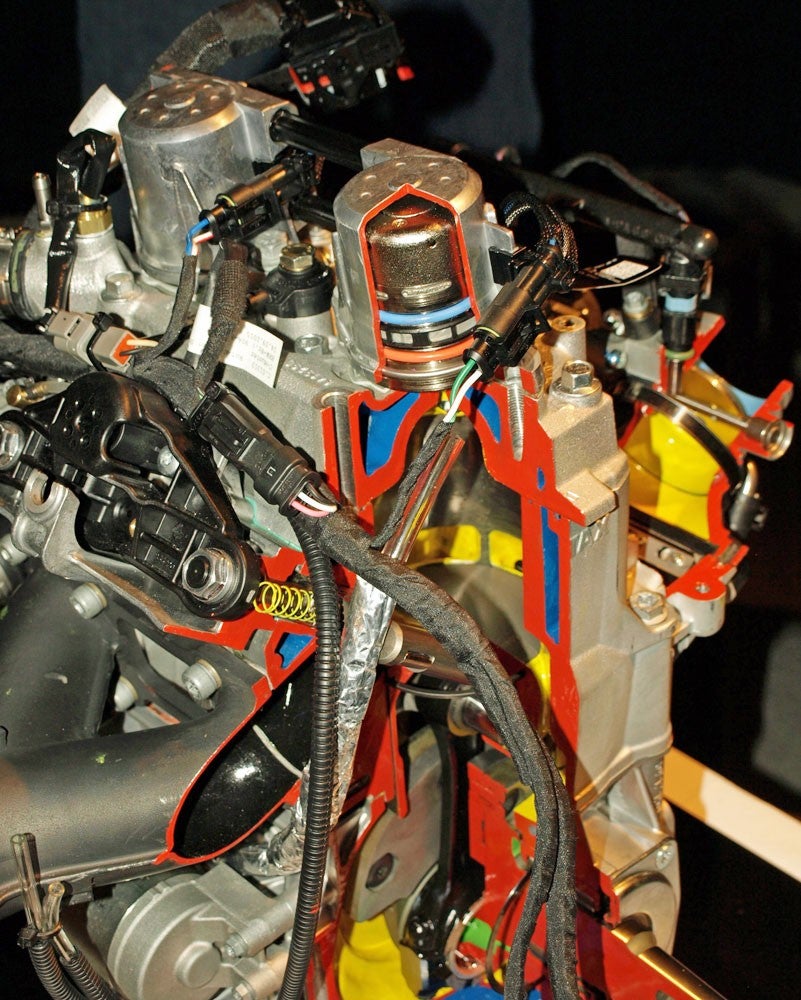
The second generation Rotax ETEC design incorporates a more powerful electronic control module, power boosters and oiling system for greatly enhanced reliability and durability.
Keep in mind that the new 850 inline direct injection two-stroke was designed right along with the all-new platform. Because of that, Ski-Doo and Rotax engineers worked together to create a well-balanced end product. Not only is the 850 engine narrowed up by 1.6 inches, but the entire drive package of engine and new pDrive clutch is 4.1 inches narrower than the old 800R ETEC. It is centered on the GEN-4 platform to create a virtual 50/50 side-to-side weight distribution. Ski-Doo engineers felt that the front-to-rear weight balance was exactly where they wanted it and creating a centered side-to-side balance gave the sled the on-trail handling they were seeking.
You will notice that the sled corners consistently from right to left and its weight transfer fore and aft remains as consistent as before. These engineers worked hard to get the handling to work this well and retain the famed REV rider-forward control. Still, though, the GEN-4 is more than a stamped out frame. It is what holds the premium pieces together that creates this new whole. The new front suspension area is a vacuum die cast aluminum structure that cuts 1.4 pounds while adding strength to support the new RAS 3 front suspension that adds an inch of travel on the MXZ to 9.2 inches. This updated design maintains toe-out ski orientation just as the previous RAS 2 did, but the RAS 3 is specifically purposed for the new GEN-4 and works with the MXZ X 850’s more precise rack steering system that is claimed to eliminate bump steer and reduce trail feedback through the handlebars.
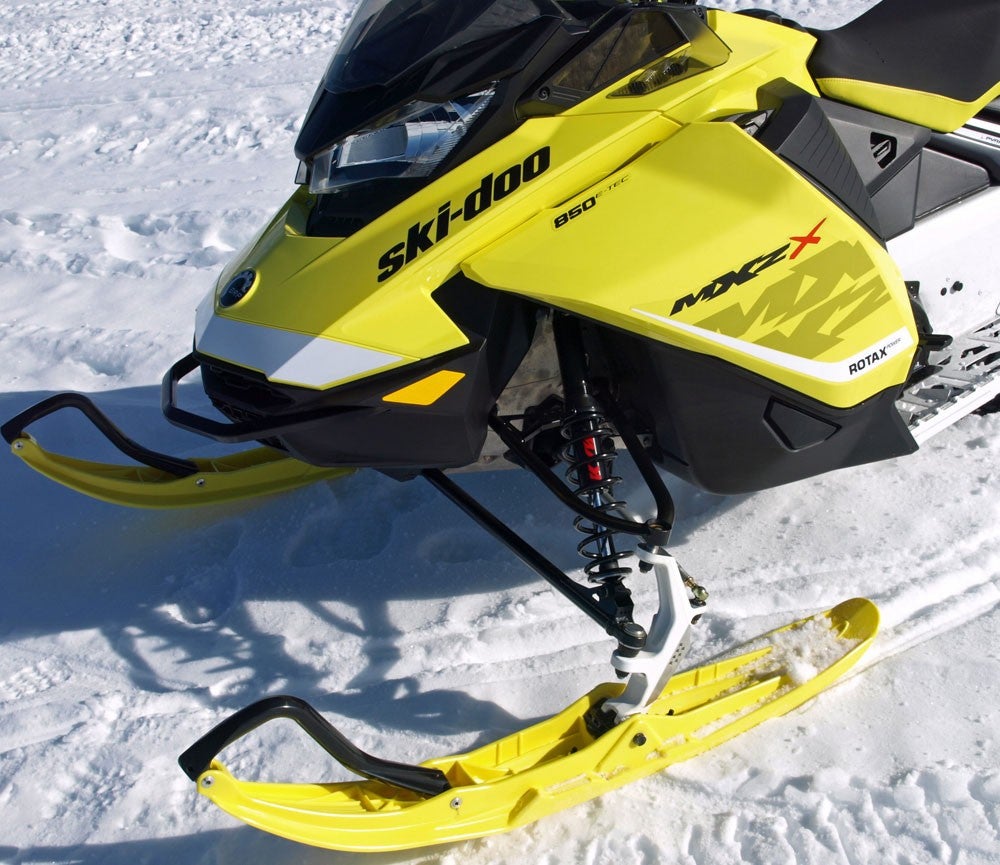
With more than nine inches of RAS 3 front suspension travel to complement the rMotion rear suspension, the 2017 MXZ X 850 is one of the sport’s premier handling performance sleds.
Ski-Doo innovates steering and onboard handling with its Forward Adjustable Riser (FAR), standard on the MXZ X 850 but offered as an option for the new MXZ TNT 850. This is a truly slick, easy-to-operate system that offers four ride settings virtually all in the same vertical plane. The FAR steering offers settings replicating the aggressive handlebar positioning for the MXZ XRS to the more composed TNT setting.
This is an incredibly rider-friendly design that can be adjusted as you cruise, but Ski-Doo recommends you make changes while stopped. With it you can hunker down for aggressive quick turning actions or slide back and set up for a comfortable cruise. Although Arctic Cat offered an ergonomic rider-centric handlebar arrangement on its four-stroke Z1 back in 2007, Ski-Doo’s new system feels much more intuitive, operates much easier, and doesn’t change the steering height but adjusts the position fore and aft for better rider control – and comfort.
Because this is all new, Ski-Doo opted to create a beveled tunnel, which allows for a narrower seat and gives you more onboard leg comfort. The new “Trail” seat gets quite narrow at the front like a motocross bike but retains a flat and wide “Karadashian” butt retention area. If you like to attack the corners, you’ll really like this new seat design. And, if you prefer cruiser comfort, it’ll work well for that, too.
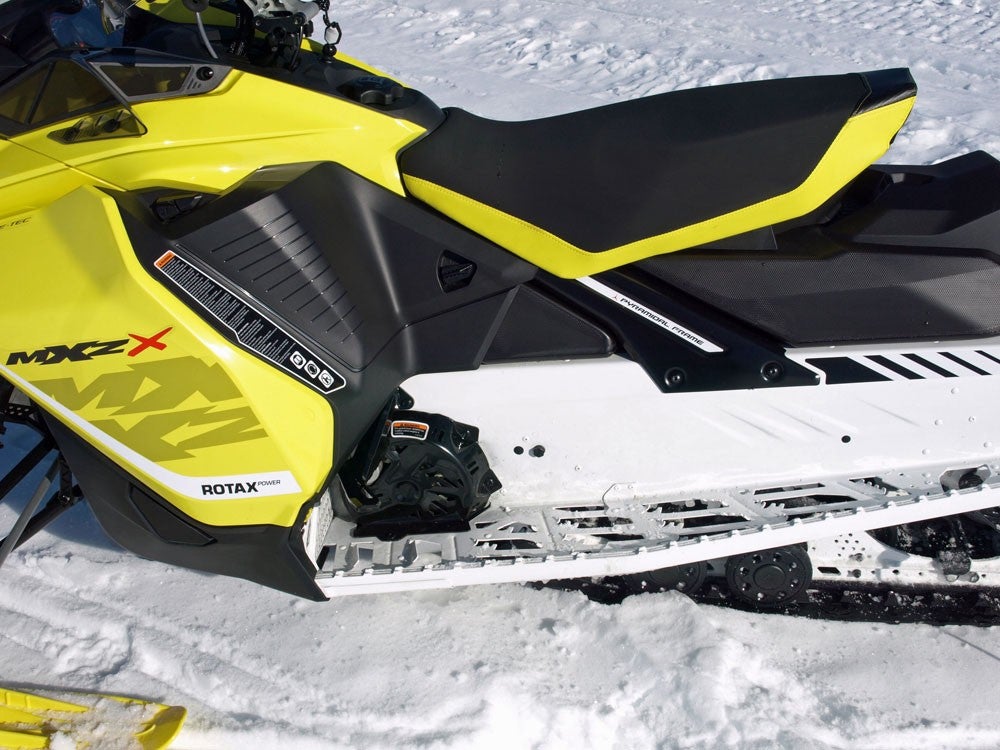
The new “trail” seat features a very narrow front area to enhance rider movement complemented by a large bun pad for comfy cruising. Note the open foot area and flat runningboard.
Because the sled has been slimmed down from the previous generation, the sled’s side panels are tucked inward. It’s a good thing on the 850 Summit that needs to slip through snow when sidehilling. It’s not a true necessity on the trail version MXZ, which leads us to our major complaint. These Ergo-Step side panels are cut in on the foremost area of the runningboard foot well area and seem to preclude a protective foot support. Ski-Doo calls this the “open toe hold.” It is a deliberately engineered-in feature designed to give aggressive riders an extreme lean-in when cornering. There is an upper foot hold area for you to brace and gain leverage. Ski-Doo had to know that some of us would find fault with this, so there is an accessory side brace.
We agree that overall the Gen-4 platform is a big winner, but we take exception to this “open toe” boot area. Ski-Doo feels that the ergo-step side panels create rider freedom that permits you to slip naturally into three different riding configurations. We don’t deny that these cut-out panels and the open foothold architecture do that. Maybe we don’t “get” this new world of snowmobile riding. When we needed to go fast, we tended to lock into a sled’s toe holds so we could keep a lighter grip on the handlebar for quick response. Without the security of serious toe holds, we fashion a death grip on the bars, which we feel is more tiring and leaves us fighting the sled as opposed to “going” with it.
Our feeling is that Ski-Doo did a terrific job with this sled. But since the chassis comes in a variety of lengths for MXZ trail riders, Renegade off-trail riders and Summit powder riders, the side panel foot hold seems to be compromised in favor of powder riders. Our Western test riders like the set up on the Gen-4 Summit. They liked the openness, the spaciousness, the flatness and more forward location of the foot wells for their mountain riding needs. Works for them, not so much for us. This is not the first time we’ve expressed displeasure with Ski-Do for its open foot platforms. We didn’t care much for Ski-Doo’s original Everest and Blizzards of the 1970s and 1980s that had a similar open architecture where you placed your boots. It’s not a big deal on well groomed trails, but keeping your feet tucked in on rough trails can be disconcerting.
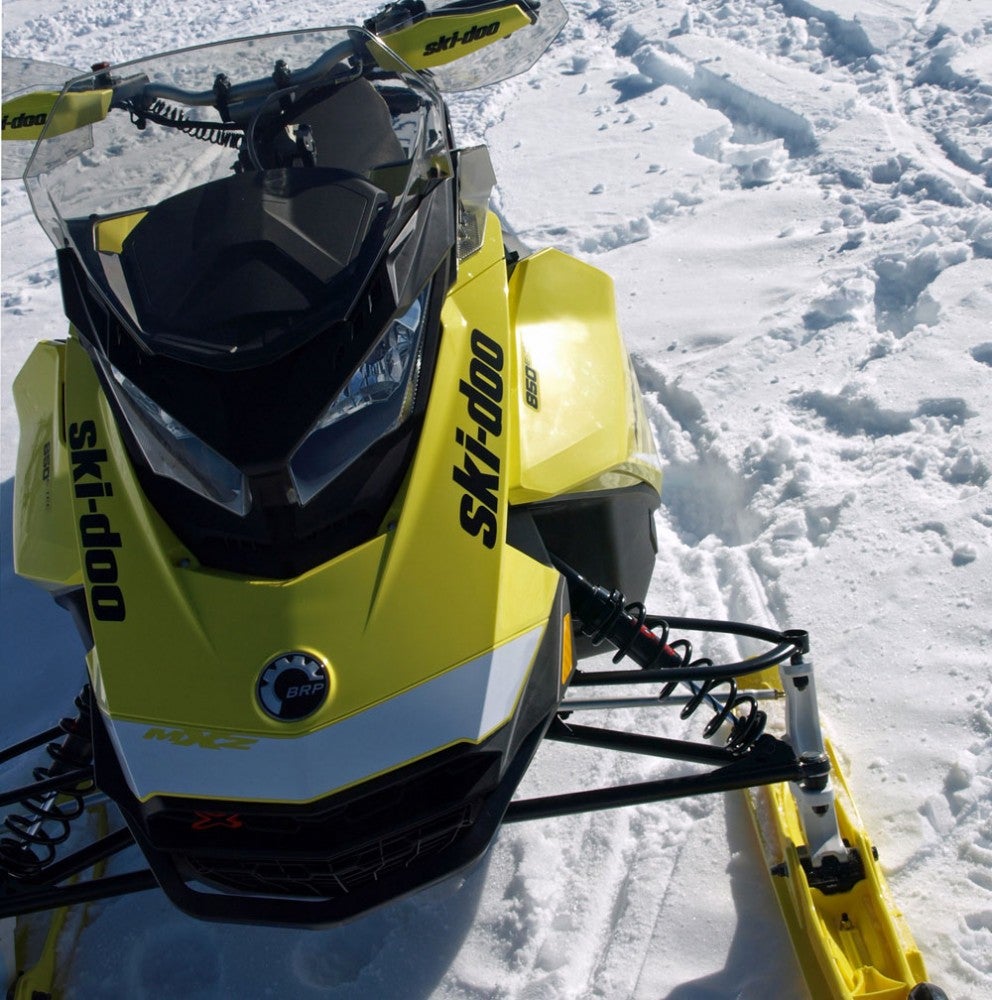
The MXZ X 850 offers abundant windscreen as well as handguard protection. The wide headlights project a swath if light for night riding, but offers a distinct appearance for daytime travel as well.
Okay, probably not a big deal, but remember this is a performance sled with an all-new performance twin that is likely the most powerful normally aspirated two-stroke for 2017. Let’s focus on performance, which the new 850 direct-injected two-stroke most assuredly has in spades. Rated at 165 horsepower at 7900 revs, Rotax’ latest ETEC twin should easily match the competition, namely Polaris’ 800 Cleanfire and Arctic Cat’s Suzuki-built 800 two-stroke twin. All of these top-of-the-line normally aspirated two-stroke 800s give away horsepower to the Cat/Yamaha 998cc four-stroke turbo, which is technically in this “800” high performance category. It’s at least about 15-horses stronger based on Yamaha’s claimed 180 hp. But, if you believe an early independent dyno run conducted on a pre-production Yamaha turbo that claimed consistent dyno pulls at 200-plus horsepower, the power differential could be too much to overcome for any of the 800cc two-strokers.
Among its peers of fuel injected two-strokes, the MXZ X 850 twin is very smooth at most posted trail speeds (about 50 miles per hour), but comes on wicked strong just north of mid-throttle when its power boosters kick in. This is definitely by design. A set of power boosters was added at the intake on this second generation ETEC system to create instant and, as Ski-Doo notes, forceful response when you snap the throttle in the mid or high rev range. Believe it!
The 850 engine’s throttle body is 35% closer to the cylinder than on the 800R ETEC. Ski-Doo claims 30% quicker throttle response, but expects that fuel mileage should be equivalent to the previous 800R ETEC at around 19 miles per gallon. However, oil efficiency should be upwards of 40% better than with the 800R ETEC.
The improvement in oil usage comes from a number of engine improvements such as: use of a friction reducing plasma coating; more precise engine electronic control module; more durable piston ring carrier; direct oil crank bearings and the ability to directly place oil onto the bearings.
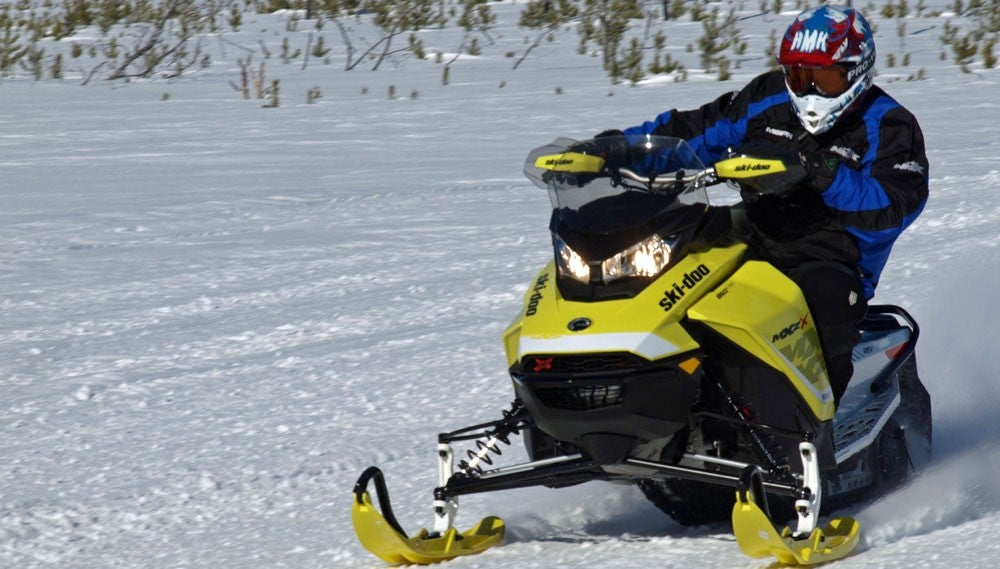
The new fourth generation of REV embraces Ski-Doo heritage in its styling and all-new on-trail performance from the GEN-4 chassis and grip of its RAS 3 front end.
Of course, while the new 850 engine is larger in displacement, utilizes new electronic technologies and power boost injection, its power needs to be properly controlled to maximize the bite of the 15-inch wide by 129-inch long RipSaw track. Enter the new pDrive driven clutch, which features friction-free rollers instead of the TRA clutch slides for transferring torque. The new pDrive is said to be nearly three pounds lighter and 11mm narrower than the tried and true TRA design. If you think the design seems familiar, then you must be a racing fan as it was tested out on Ski-Doo’s 2016 MXZx 600 RS racing sled.
Ski-Doo engineering and stylists did an excellent job with this fourth generation REV. The designers and styling guru captured the “Ski-Doo” essence and heritage. The Ski-Doo and Rotax performance mavens blended in power, performance and handling.
Plus, Ski-Doo product planners anticipated that Ski-Dooers would want to customize their ride. You will find accessories designed to fit these new Generation 4 models as though they were part of the original package. That was the intent as many of the parts and accessories were engineered right along with the sled almost from the very beginning. Accessory fit and finish is superb and adds a new level of personalization to snowmobiling.
Like we said, Ski-Doo did an excellent job overall. The MXZ X 850 is strong with a quick hitting mid-throttle power boost. It is extremely well balanced for aggressive riding, definitely the best handling REV to date! It has “heritage” styling and an incredible supply of options to make this sled a customized one-of-a-kind if you want.
| 2017 Ski-Doo MXZ X 850 E-TEC Specs | |
| Engine | NEW: Rotax 849cc, liquid-cooled two-cylinder 2-stroke; Rotax “ETEC” electronic direct injection with power booster injectors |
| Horsepower | 165 @ 7900 rpm (claimed) |
| Drive | Ski-Doo/Rotax pDrive with QRS; engagement @ 3800 rpm |
| Brake | Brembo hydraulic racing brake system with braided stainless steel line |
| Front Suspension | RAS-3 double A-arm with HPG Plus aluminum bodied gas shocks; up to 9.2 inches of travel; Pilot 5.7 ski standard with optional Pilot TS available |
| Rear Suspension | rMotion parallel slide rail with aluminum body HPG Plus center shock and KYB Pro 36 rear shock; up to 10.7-inches of travel (rMotion Quick Adjust optional) |
| Length | 118.5 in |
| Width | 47.2 in |
| Height | 48.1 in |
| Ski Stance | 41.7 in |
| Track | 15 x 129 x 1.25 RipSaw |
| Weight | 475 |
| Fuel Capacity | 9.5 US Gal (91 Octane premium fuel) |
| Features | Generation 4 REV platform; gauge with LCD screen; trail performance seat; push button mechanical reverse; standard electric start; all-new forward adjustable riser; aluminum handlebar with J-hooks |
| MSRP | US$13,199 |



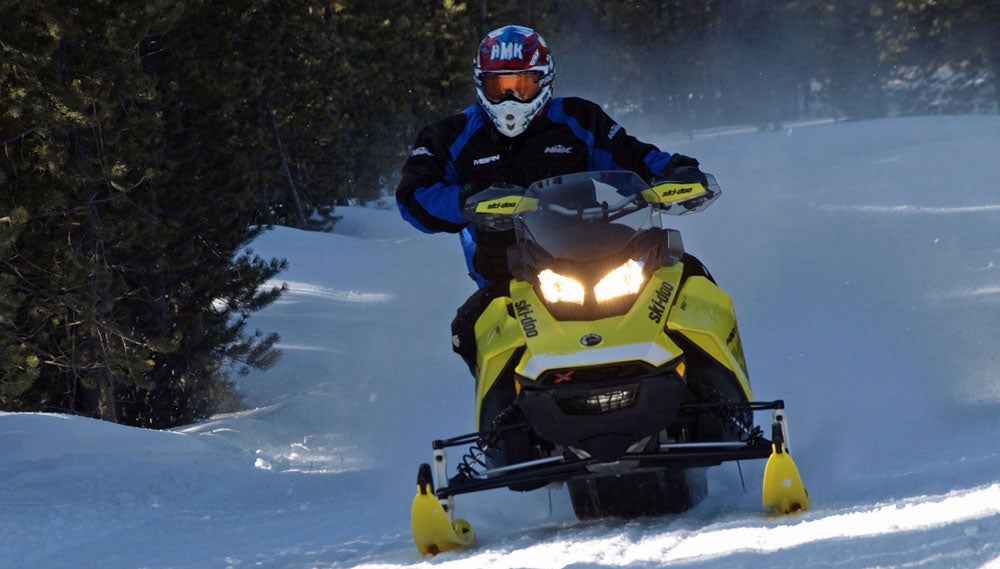
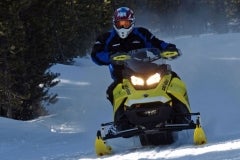
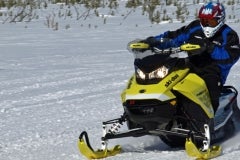
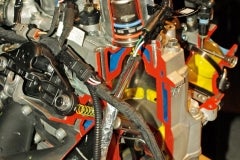
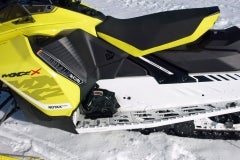
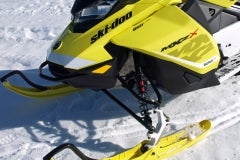
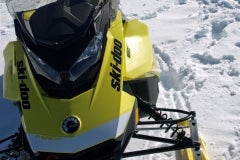
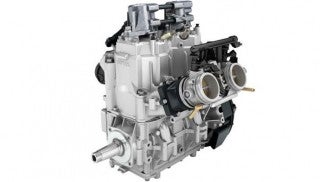

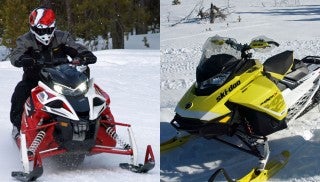


 Your Privacy Choices
Your Privacy Choices